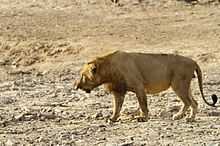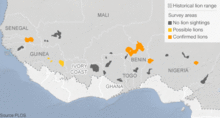West African lion
| West African lion | |
|---|---|
 | |
| West African male lion from Pendjari National Park, Benin. | |
| Scientific classification | |
| Kingdom: | Animalia |
| Phylum: | Chordata |
| Class: | Mammalia |
| Order: | Carnivora |
| Family: | Felidae |
| Genus: | Panthera |
| Species: | Panthera leo |
| Subspecies: | P. l. senegalensis |
| Trinomial name | |
| Panthera leo senegalensis (Meyer, 1826) | |
 | |
| Lions now roam in just 1.1% of their historic range in West Africa. | |
The West African lion (Panthera leo senegalensis), also known as the Senegal lion, is a lion subspecies native to western Africa. Results of genetic research indicate that the Western and Central African lions form a different clade of lions and are perhaps more related to Asian lions than to lions from southern or eastern Africa. The genetic distinctiveness is particular of interest, since lions are regionally endangered in western Africa. With a total population of perhaps less than 1,000 individuals in all of West and Central Africa and no captive population, the West African lion is one of the most endangered subspecies of big cats.[1]
Characteristics
Lions from western and central Africa are believed to be smaller than lions from southern Africa. It is also suggested, that they have smaller manes, live in smaller groups, and they may also differ in the shape of their skull.[2][3] In the Pendjari National Park area, which is within the range of the West African lion, almost all males are maneless or have very weak manes.[4]
Distribution and population status

The West African lion is distributed in western Africa south of the Sahara from Senegal in the west to the Central African Republic in the east. Another subspecies (P.l. azandica) or North East Congo lion is traditionally described from northeastern Democratic Republic of the Congo.[5]
Lions are rare in western Africa and may be critically endangered in this region.[6] In 2004 there were probably only 450-1,300 lions left in West Africa. In addition, there were about 550-1,550 in Central Africa. In both regions, the area inhabited by lions has been reduced until 2004 to less than 15% of the historic range.[1]
A recent study, which took place between 2006 and 2012, revealed, that lions have declined even further in West Africa. Only about 400 lions (range: 250–587) remained in the whole area between Senegal and Nigeria. The largest population of West African lions is found in the so called WAP-Complex, a large system of protected areas formed mainly by Arli, Pendjari, and W National Parks in the states Burkina Faso, Benin, and Niger. The total population in this ecosystem comprises about 350 lions (range: 246–466). The other populations in West Africa consist of only a few individuals and are probably declining. They are found in Niokolo Koba National Park in Senegal and two places in Nigeria. In Nigeria, there are two small populations left, one in Kainji Lake National Park and another one in Yankari Game Reserve. The population at Kainji Lake might be connected to that of the WAP-Complex. There are probably no lions left in the Republic of Congo, Côte d’Ivoire and Ghana.[7][8][9]
In Central Africa a large population of 100-400 lions is found in Bénoué ecosystem in Cameroon. Smaller populations in Central Africa exist in Waza National Park in Cameroon and Zakouma National Park in Chad. Within Central African Republic there are perhaps only about 150-500 lions left. Other estimates count 1,252 lions within the country, but numbers in Central Africa are generally believed to be not reliable.[1][10]
| Lion area | Habitat Area (km2) | Estimated Population |
|---|---|---|
| Niokolo-Guinea (Senegal, Guinea, Guinea Bissau and Mali) | 90,384 | >50[10] |
| W-Arly-Pendjari (Benin, Burkina Faso, Niger) | 29,403 | 246 - 466[11] |
| Benin (except Pendjari) | 3,152/1,742/4,171 | 3/18/19[10] |
| Kainji Lake (Nigeria) | 4,171 | 32[10] |
| Yankari (Nigeria) | 2,380 | 2[10] |
| Bénoué Complex (Cameroon) | 14,682 | 200[10] |
| Waza National Park (Cameroon) | 1,452 | 17[10] |
| Zakouma Region (Chad) | 133,408 | 75-400[1][10] |
| Central African Republic | 339,418 | 150-1,252[1][10] |
| Western South Sudan (South Sudan) | 331,834 | 375[10] |
| Total | 1145-2,834 |
Some lion populations in Central Africa are outside the range, originally described for the West African lion. In the Democratic Republic of Congo there are about 175 lions in the area of the Garamba National Park and 60 lions in Virunga National Park. The latter form a contigous population of about 210 lions with lions in Uganda.[1][5][10] These lions fall within the range of the Congo lion.
Captive population
In 2006 there were 13 captive animals registered under the name P. l. senegalensis.[6] However, these lions, which are mainly kept in Australian zoos, are in fact not West African lions in the strict sense, but African lions in a broader sense. So there is no known West African lion population in captivity.
References
- ↑ 1.0 1.1 1.2 1.3 1.4 1.5 Bauer, H.; Van Der Merwe, S. (2004). "Inventory of free-ranging lions Panthera leo in Africa". Oryx 38. doi:10.1017/S0030605304000055.
- ↑ Bertola, L., de Iongh, H., Vrieling, K. (2011). Researchers confirm West and Central African lion is different from other lions. University of Leiden. Institute of Environmental Sciences (CML). Faculty of Science. Last Modified: 01-04-2011.
- ↑ Bertola, L. D.; Van Hooft, W. F.; Vrieling, K.; Uit De Weerd, D. R.; York, D. S.; Bauer, H.; Prins, H. H. T.; Funston, P. J.; Udo De Haes, H. A.; Leirs, H.; Van Haeringen, W. A.; Sogbohossou, E.; Tumenta, P. N.; De Iongh, H. H. (2011). "Genetic diversity, evolutionary history and implications for conservation of the lion (Panthera leo) in West and Central Africa". Journal of Biogeography 38 (7): 1356. doi:10.1111/j.1365-2699.2011.02500.x.
- ↑ Schoe, M., Sogbohossou, E. A., J. Kaandorp, H. de Iongh (2010). Progress Report – collaring operation Pendjari Lion Project, Benin. Dutch Zoo Conservation Fund.
- ↑ 5.0 5.1 Sunquist, M. E. & F. C. Sunquist (2009). "Family Felidae (Cats)". In D. E. Wilson, R. A. Mittermeier. Handbook of the Mammals of the World. Volume 1: Carnivores. Barcelona: Lynx Edicions. pp. 137 ff. ISBN 978-84-96553-49-1.
- ↑ 6.0 6.1 Barnett, R., N. Yamaguchi, I. Barnes and A. Cooper (2006). The origin, current diversity and future conservation of the modern lion (Panthera leo). Proc. R. Soc. B (2006) 273: 2119–2125 doi:10.1098/rspb.2006.3555 PMID 16901830
- ↑ Henschel, P., D. Azani, C. Burton, G. Malanda, Y. Saidu, M. Sam, L. Hunter (2010). Lion status updates from five range countries in West and Central Africa. Cat News 52: 34-39.
- ↑ Bauer, H., Nowell, K. & Packer, C. (2008). "Panthera leo". IUCN Red List of Threatened Species. Version 2014.2. International Union for Conservation of Nature.
- ↑ Henschel, P.; Coad, L.; Burton, C.; Chataigner, B.; Dunn, A.; MacDonald, D.; Saidu, Y.; Hunter, L. T. B. (2014). Hayward, Matt, ed. "The Lion in West Africa is Critically Endangered". PLoS ONE 9: e83500. doi:10.1371/journal.pone.0083500.
- ↑ 10.0 10.1 10.2 10.3 10.4 10.5 10.6 10.7 10.8 10.9 10.10 Riggio J, Jacobson A, Dollar L, Bauer H, Becker M, Dickman A, Funston P, Groom R, Henschel P, de Iongh H, Lichtenfeld L, Pimm S (2012). The size of savannah Africa: a lion's (Panthera leo) view. Biodiversity Conservation.
- ↑ Henschel P, Coad L, Burton C, Chataigner B, Dunn A, et al. (2014). The Lion in West Africa Is Critically Endangered. PLoS ONE 9(1): e83500
External links
| Wikimedia Commons has media related to Panthera leo senegalensis. |
- Photos of West African lions at Pendjari National Park at flickr
- Wildlife extra: Lions from west and central Africa have more in common with Asiatic lion
- ROCAL West and Central African lion conservation network
- Henschel, P. (2014). "Lions 'facing extinction in West Africa'". BBC News. Retrieved 2014-01-26.